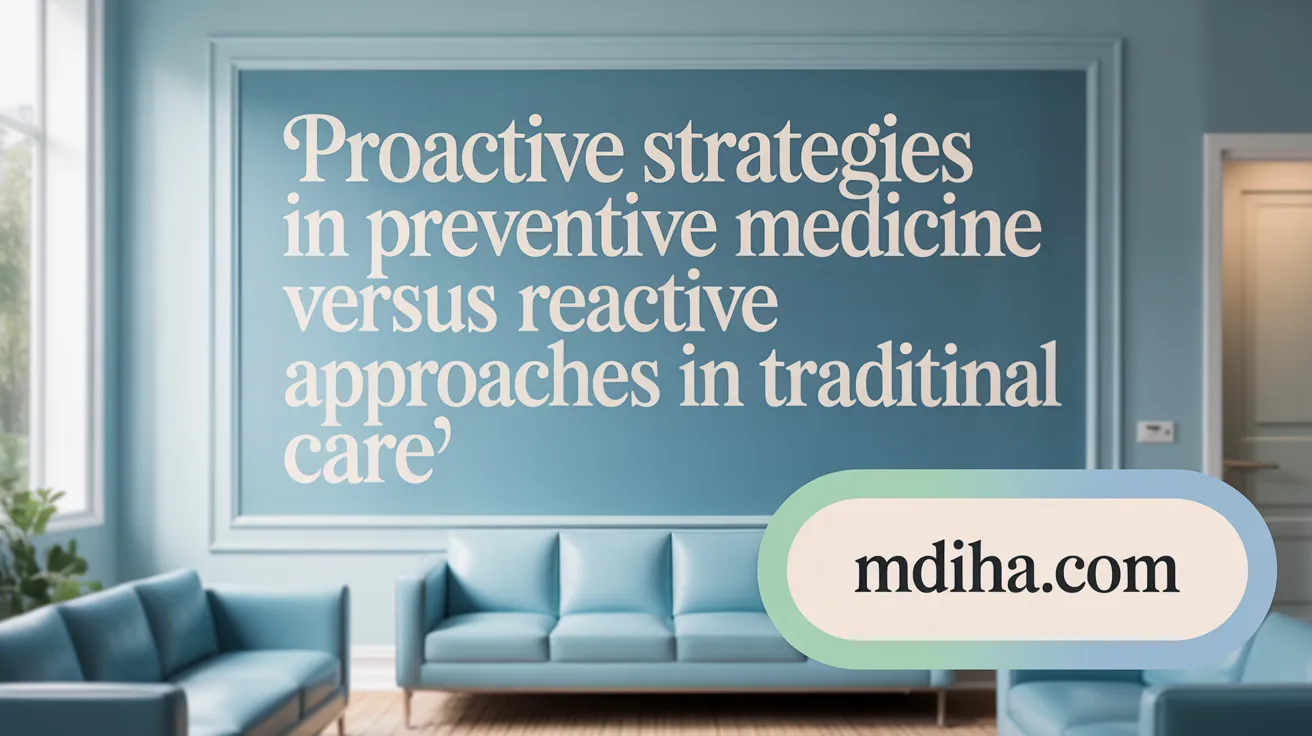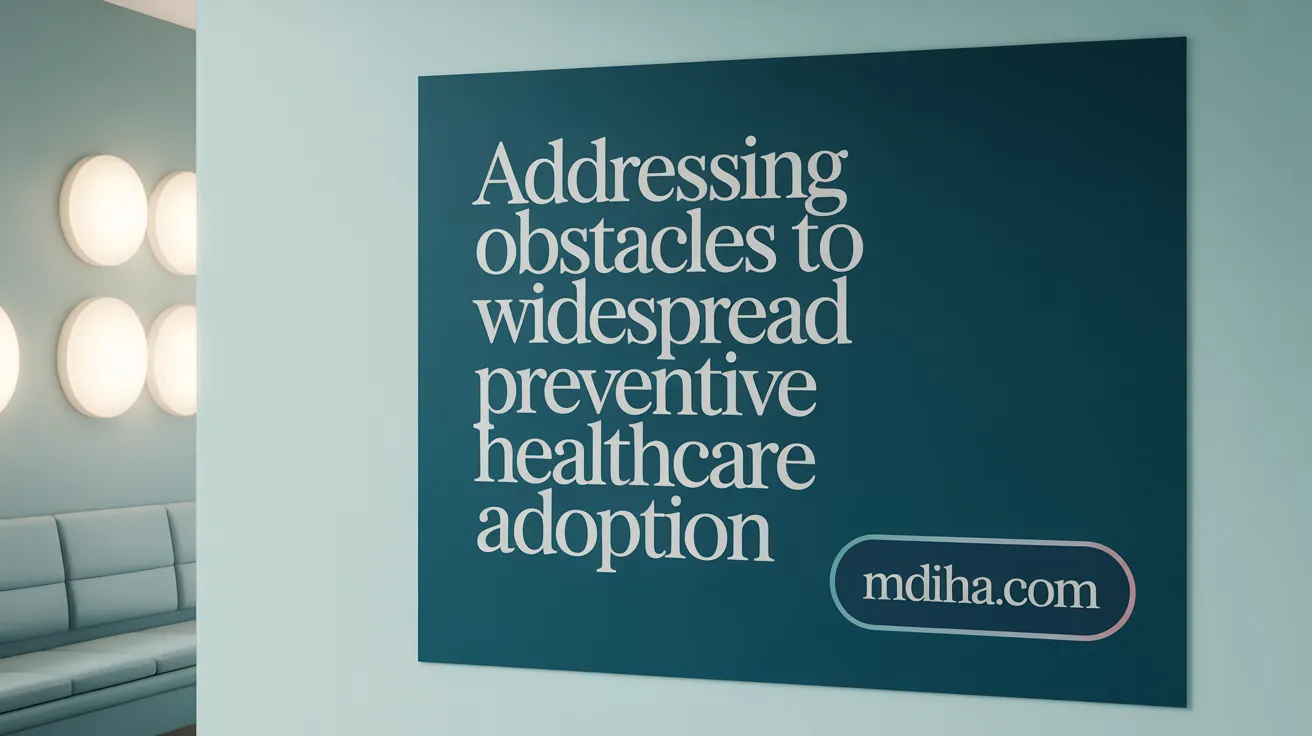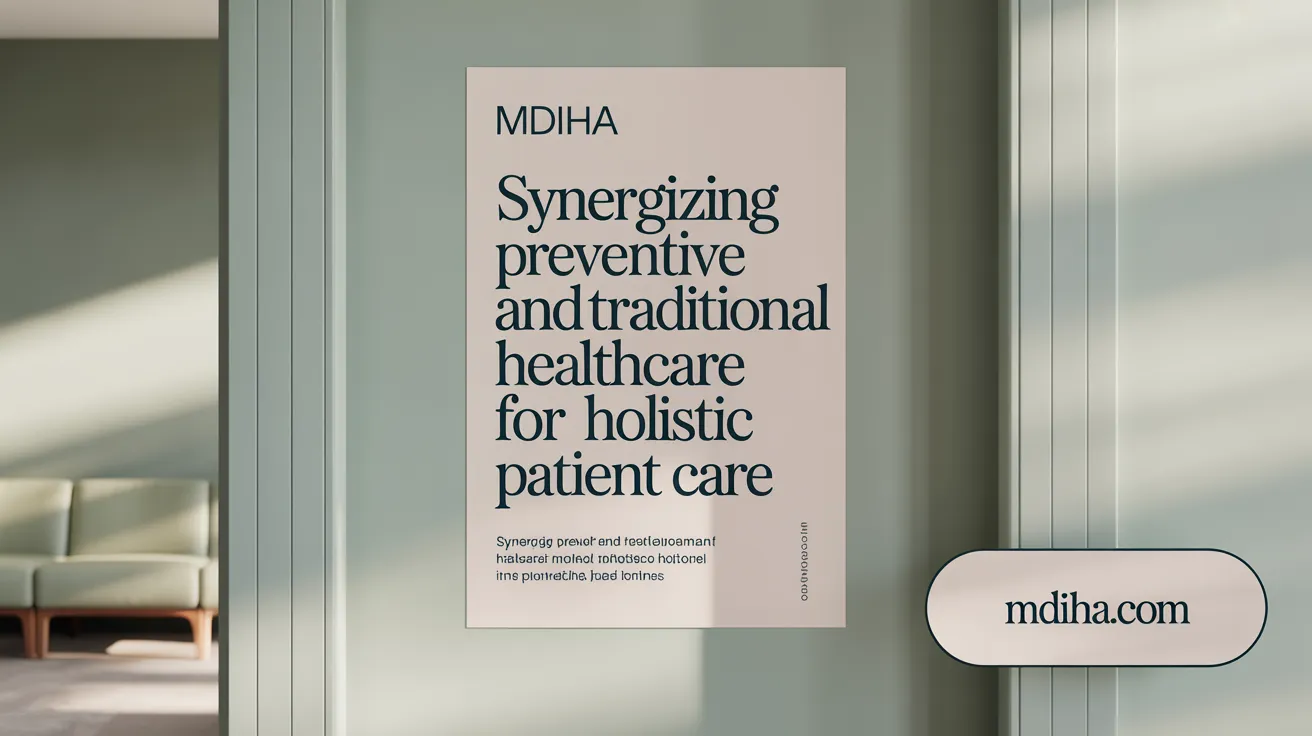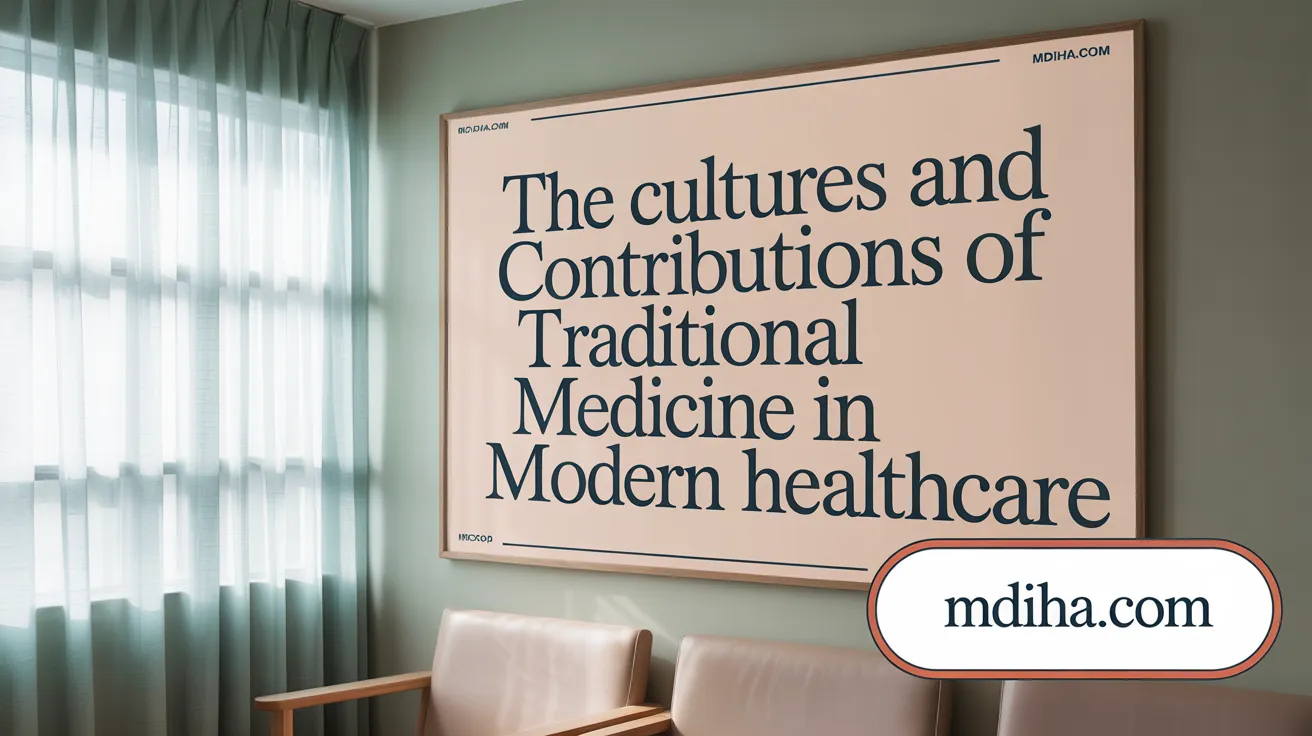Setting the Stage: What Distinguishes Preventive Medicine from Traditional Healthcare?
Preventive medicine and traditional healthcare are often viewed as two distinct paradigms in health management. While traditional healthcare typically reacts to symptoms and illnesses once they manifest, preventive medicine focuses on proactive strategies aimed at maintaining health and preventing disease. Understanding these differences is essential for appreciating how each approach contributes to individual and public health, as well as the broader healthcare system.
Core Principles and Goals of Preventive Medicine versus Traditional Healthcare

What are the main differences in focus and approach between preventive medicine and traditional healthcare?
Preventive medicine emphasizes a proactive approach to health. Its primary goal is to stop diseases before they develop by implementing early interventions such as vaccinations, routine screenings, and lifestyle modifications. This approach helps maintain health and reduces the incidence of illness.
In contrast, traditional healthcare tends to be reactive. It primarily focuses on diagnosing and treating diseases once symptoms have appeared. This treatment often involves medications, surgeries, and therapies aimed at curing or managing established health conditions.
What are the levels of prevention in healthcare, and which does traditional healthcare primarily address?
Preventive medicine operates across three distinct levels:
- Primary Prevention: Actions that prevent disease onset, including immunizations and health education.
- Secondary Prevention: Early detection of diseases through screenings to halt progression.
- Tertiary Prevention: Managing existing conditions to improve quality of life and avoid complications.
Traditional healthcare mainly addresses the secondary and tertiary levels by treating health problems that have already developed or manifested symptoms.
Preventive care utilizes vaccinations, health education, and lifestyle changes to minimize risks, alongside screenings that allow for early disease identification. These strategies distinguish it from the more reactive and treatment-oriented traditional care, underscoring preventive medicine's role in reducing disease burden and improving overall health outcomes.
Methods and Strategies in Preventive Medicine Compared to Traditional Healthcare

What are typical preventive services, and how do they contribute to health?
Preventive medicine emphasizes proactive health measures designed to stop diseases before they begin or to catch them early when treatment is most effective. Typical preventive services include immunizations that protect against infectious diseases like measles and influenza, routine screening tests such as mammograms, colonoscopies, cholesterol and blood pressure checks, and health education on lifestyle modifications like diet and exercise. These services help detect risk factors or early signs of illness, enabling timely intervention. This approach improves health outcomes, reduces disease incidence, and lowers long-term healthcare costs by avoiding advanced disease complications (Preventive healthcare strategies, Preventive Care Benefits).
How does traditional healthcare treat diseases once they appear?
Traditional healthcare adopts a reactive stance, addressing diseases after symptoms or complications have developed. Its practices involve the use of medications to control or cure conditions, surgeries to correct physical issues, therapies for rehabilitation, and emergency care for acute or life-threatening situations. This approach focuses on managing and alleviating symptoms, limiting disease progression, or restoring function after disease onset (Traditional medicine overview, Traditional Healthcare Practices).
Preventive Measures: Immunizations, Health Education, Lifestyle Interventions
Preventive strategies focus on health maintenance through vaccinations, which preempt infectious diseases, and comprehensive health education that empowers individuals to make informed lifestyle choices (Health education and empowerment in health management). Lifestyle interventions target modifiable risk factors such as poor diet, physical inactivity, and smoking, intending to reduce the development of chronic diseases (Integrative medicine overview, Lifestyle medicine pillars).
Screening Tests and Early Detection Methods
Screening programs identify diseases like cancer, hypertension, and diabetes early, often before symptoms appear. Early detection through mammograms, colonoscopies, and blood tests allows for interventions that can prevent disease progression and complications (Early disease detection and intervention, Preventive Medicine Overview).
Management of Chronic Diseases through Prevention
Preventive healthcare also emphasizes managing risk factors and early-stage chronic diseases to prevent complications. Through lifestyle medicine and integrative approaches, including nutrition and stress management, patients can control or even reverse conditions such as diabetes and heart disease (Preventive care in chronic disease management, Integrative Medicine Benefits).
Traditional Healthcare Practices: Medications, Surgeries, Emergency Care
In contrast, traditional healthcare practices typically engage when diseases manifest, employing pharmaceutical treatments, surgical interventions, and acute care procedures to treat symptoms and manage established illnesses (Traditional medicine overview, Pharmaceutical use in traditional medicine).
Role of Public Health and Personalized Care in Prevention
Preventive approaches integrate public health initiatives—like vaccination programs and health awareness campaigns—with personalized care, tailoring prevention plans to individual risk profiles and needs (Personalized preventive strategies, Public health and immunizations). This combination enhances effectiveness and accessibility of prevention efforts.
By focusing on early action and health maintenance, preventive medicine complements traditional healthcare, together forming a comprehensive healthcare system that optimizes patient outcomes and resource use (Preventive vs traditional healthcare, Balancing Proactive and Reactive Healthcare).
Economic and Health Outcomes: Cost-Effectiveness and Quality of Life Implications
How does preventive healthcare affect healthcare costs compared to traditional healthcare?
Preventive healthcare significantly lowers long-term healthcare expenses by focusing on early detection and intervention. This approach avoids the need for more invasive, complex, and costly treatments often required in traditional healthcare, which typically addresses diseases only after they manifest. By preventing disease onset through vaccinations, screenings, and lifestyle modifications, preventive care reduces hospitalizations and expensive emergency interventions, thus easing the financial burden on healthcare systems.
Cost savings from early disease detection
Early detection using routine screenings such as mammograms, colonoscopies, and blood pressure checks enables timely treatment that is less invasive and less costly. Detecting illnesses at an initial stage often means simpler treatment protocols and fewer complications, which translates into substantial healthcare savings.
Reduced need for invasive and expensive treatments
Preventive care helps avoid advanced-stage diseases that require surgeries, long-term medications, or complex therapies common in traditional care. For example, managing diabetes early can prevent costly complications like dialysis for kidney failure or amputations related to uncontrolled blood sugar.
Impact on healthcare expenditure and resource allocation
By shifting focus towards prevention, healthcare resources can be allocated more efficiently. Preventive measures reduce the demand for high-cost hospital care and allow for a more sustainable healthcare system prioritizing health maintenance over reactive treatment (Proactive Healthcare vs Reactive Healthcare.
What are the benefits of preventive care on patients’ quality of life?
Preventive care enhances longevity and quality of life by minimizing the progression of chronic diseases and improving overall health. It supports healthier lifestyles which decrease disability and improve mental and physical well-being. Patients benefit from fewer complications, less pain, and a lower risk of premature death (Benefits of Preventive Medicine.
Traditional healthcare costs related to treating advanced diseases
Traditional healthcare incurs greater expenses as diseases treated at advanced stages often require prolonged hospitalization, multiple specialists, and extensive pharmacological intervention. Such reactive treatment is not only costly but may also result in poorer health outcomes compared to proactive preventive strategies.
Challenges and Barriers in Implementing Preventive Healthcare Practices

What barriers limit the utilization of preventive healthcare services?
Several factors hinder the widespread use of preventive healthcare. A major barrier is the lack of awareness among patients about available clinical preventive services (CPS) and their benefits. Financial constraints also play a significant role, even though many plans cover preventive care at no cost — gaps in knowledge about coverage persist. Access issues, such as shortage of primary care providers, transportation difficulties, and geographic distance from healthcare facilities further reduce uptake. Social determinants of health, including systemic inequities, stigma related to mental health or cognitive screenings, and cultural factors, additionally act as obstacles. Together, these barriers contribute to a decline in the utilization of clinical preventive services, as seen in the drop from 8.5% in 2015 to 5.3% in 2020 among adults aged 35 and older.
Why does health care delivery often favor reactive over preventive care?
The structure of healthcare delivery often prioritizes reactive healthcare treatment over preventive care. Reimbursement models largely focus on managing active diseases, with limited compensation for preventive counseling and interventions. This creates financial disincentives for providers to emphasize preventive care. Time constraints during clinical visits and insufficient training in preventive approaches further diminish prevention efforts. The "prevention paradox," where benefits of preventive measures are less visible at the individual level, can cause resistance among both patients and providers. As a result, the system tends to emphasize diagnosing and treating illnesses after symptom onset rather than investing resources into early detection and health maintenance.
Addressing these challenges requires systemic reforms that include better education, enhanced insurance coverage awareness, inclusion of prevention in medical training, and restructuring reimbursement to support comprehensive preventive care.
Integration and Complementarity: Combining Preventive Medicine with Traditional Healthcare

How can preventive healthcare and traditional healthcare models work together effectively?
Combining preventive healthcare with traditional models creates a comprehensive, patient-centered approach that enhances health outcomes and curbs disease progression. This integration is often delivered through primary care providers who manage both acute conditions and deliver preventive services. By adding early detection screenings, immunizations, and health education within traditional care, patients receive timely interventions that can prevent complications.
Lifestyle counseling and regular wellness exams further enhance this synergy. Patients benefit from coordinated care plans that blend the reactive strengths of traditional medicine with the forward-looking focus of preventive care.
What emerging fields support this integration?
Lifestyle medicine and integrative medicine are pivotal in advancing this integrated approach. Lifestyle medicine emphasizes six pillars: nutritious diet, physical activity, quality sleep, stress management, avoidance of harmful substances, and social connections, utilizing evidence-based behavioral interventions.
Integrative medicine complements conventional treatments with natural remedies, mind-body practices, and holistic therapies drawn from traditional medicine systems such as Ayurveda or acupuncture. This fusion respects cultural backgrounds and personal preferences, supporting wellness and symptom management beyond conventional pharmaceuticals.
Examples of combining traditional and preventive strategies
- Primary care clinicians conduct routine screenings and vaccinations while advising on lifestyle adjustments to mitigate risk factors.
- Integrative clinics may offer herbal medicine or acupuncture alongside standard treatments for chronic conditions.
- Community health initiatives incorporate health education, nutritional guidance, and physical activity promotion grounded in preventive care principles, combined with access to conventional treatments.
Future trends in comprehensive healthcare
Advances in technology, including telehealth and wearable health monitoring, are expanding access to preventive and integrative services. Additionally, policy reforms are incentivizing prevention-focused care. Medical education increasingly incorporates training on preventive and integrative practices, fostering a healthcare workforce prepared for holistic patient management.
In summary, merging preventive medicine with traditional healthcare through primary care, lifestyle medicine, and integrative approaches results in effective, sustainable healthcare that addresses both prevention and treatment, improving overall population health.
Traditional Medicine’s Role and Its Relationship with Preventive Care

What is traditional medicine, and how does it relate to modern healthcare?
Traditional medicine encompasses health knowledge and practices rooted in cultural traditions, including herbal remedies, acupuncture, and holistic therapies. It serves as both a primary healthcare resource in many communities and a significant contributor to modern pharmaceuticals; for example, aspirin originated from willow bark, and artemisinin, a key malaria treatment, was derived from ancient Chinese medicine. These practices emphasize the body's natural ability to heal and often focus on managing symptoms and promoting wellness. Learn more about Traditional medicine overview, Pharmaceutical origins from traditional medicine, and Benefits of Traditional Medicine.
How can traditional medicine complement preventive and conventional healthcare?
Integrating traditional medicine with modern preventive and conventional approaches enhances health outcomes by addressing root causes and supporting chronic disease management. Traditional practices promote prevention through lifestyle changes and natural remedies, offering culturally relevant, holistic care that respects individual needs. When combined with vaccinations, screenings, and medical treatments, traditional therapies contribute to a more comprehensive and personalized healthcare model. See more on Benefits of preventive healthcare, Combining Functional and Traditional Medicine, and Preventive Medicine Overview.
Traditional medicine highlights the importance of whole-person wellness and prevention, complementing the proactive strategies of modern healthcare. Its role in symptom relief, emotional well-being, and health maintenance fits naturally alongside preventive care efforts, supporting a balanced approach to health preservation and disease prevention. For more information, refer to Holistic Approach in Traditional Medicine, Preventive care vs traditional healthcare, and Integrative Medicine overview.
Bridging the Gap: Towards a More Holistic Healthcare Future
Understanding the key differences between preventive medicine and traditional healthcare reveals the strengths and limitations of each. Preventive medicine’s proactive, early-intervention strategies complement traditional healthcare’s reactive, symptom-focused treatments. Challenges remain in shifting healthcare systems toward greater emphasis on prevention, yet integrating these approaches promises improved health outcomes, reduced costs, and better quality of life. Traditional medicine’s holistic and historical contributions enrich this landscape, offering culturally sensitive and complementary options. Ultimately, a balanced healthcare model combining prevention, treatment, and integrative practices can foster a more effective and sustainable future for patient care and public health.
